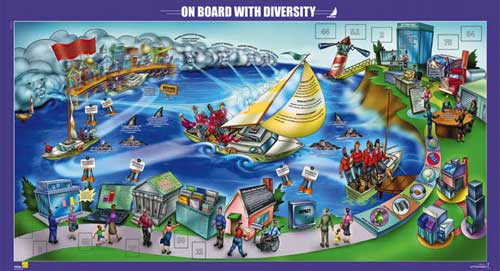 |
|

Getting the Big Picture of Diversity and Inclusion“When we rolled out our corporate Diversity and Inclusion initiative,” a frustrated diversity manager related, “we had high expectations that our employees would really ‘get it’. But now, months later, most of our employees have little or no real knowledge and little understanding of what diversity and inclusion has to do with them and the organization.” Other organizations share similar stories. D & I stakeholders launch their training initiatives and soon discover that employees retain little knowledge of the business case for D & I, the definitions, the competencies required to work successfully in a diverse and inclusive workplace and marketplace or their personal role in transforming their organization into one that leverages diversity as a competitive advantage. The success of a D & I initiative is dependent upon employees clearly understanding the business case and their individual role in creating an inclusive workplace. Success requires the message and the approach to be compelling, consistent and clear enough to personally connect employees to the initiative. The optimal communicating/learning environment for promoting D & I awareness and building inclusive skills is one in which participants are immersed in a learning experience that is relevant to their jobs and to the situations they face each day. With this in mind, PRISM developed a 4 Point D & I Communication & Learning Experience to increase knowledge retention and create buy-in. The 4 Points are designed to:
If retention and buy-in is to be increased, then the leaning methodology must be engaging! Participants must be involved! The learning experience must enable participants to explore, collaborate and share their views. This is the environment PRISM envisioned when creating their Diversity & Inclusion Knowledge Maps™. As you can see, this is NOT your traditional training session! Unlike presentations or typical learning initiatives, the Map process is extremely interactive and encourages participants to explore with their peers key issues regarding diversity and inclusion. This is adult leaning combined with an accelerated methodology at its best. Through facts and conversation participants begin to shed old assumptions, draw new conclusions, identify new roles and responsibilities and see the business case for acting on the learning. Participants in a D & I Knowledge Maps™ experience learn and discuss:
With PRISM’s Diversity & Inclusion Knowledge Maps™ the experience creates the learning. UPS, Florida Hospital, Siemens and Wellpoint are some of the many organizations using D & I Knowledge Maps™ successfully. Some of the benefits to D & I Knowledge Maps™ include:
After a PRISM D & I Knowledge Map™ experience, employees understand the big picture of diversity and inclusion. They have a shared picture of their organization’s strategy and are able to communicate it using a common language. They get the “what’s in it for me” – and they learn and practice inclusive behaviors. The Siemens Corporation remarks: "The D & I Knowledge Maps™ brings in everyday situations and shows how they impact us. The Maps are a more creative way of learning - of getting people to understand what diversity is all about - they are great tools." Wellpoint concludes: "PRISM’s D &I Maps are the best interactive tool I have seen for building the business case for diversity and inclusion consistently across an organization." Go here for more info on the Diversity & Inclusion Knowledge Maps™. 
|